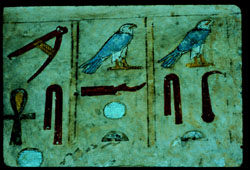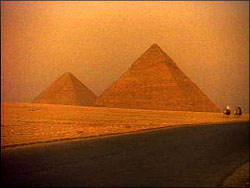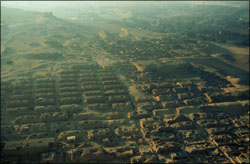
|
 Our history of Egypt begins around the year 3,000 BC with the
unification of Upper and Lower Egypt into one united kingdom. Under this new
ruling dynasty, the first King was Menes, and thirty dynasties would follow.
It was at this time that hieroglyphic writing made its first appearance, in the
tombs and treasures of the pharaohs. To seal the unification of Upper and
Lower Egypt, Menes founded the capital city of the kingdom at the place where
the two met: at the apex of the Nile, where it fans out onto the fertile silt
plain. The fortress city was named "White Walls" by Menes, but it is known
today by its Greek name, Memphis. For much of the 3,000 years of ancient
Egypt, it remained the capital seat of the pharaohs. Only 20 miles to the
north of Memphis is the modern capitol, Cairo, still situated near the juncture
of the Nile valley and the delta. Our history of Egypt begins around the year 3,000 BC with the
unification of Upper and Lower Egypt into one united kingdom. Under this new
ruling dynasty, the first King was Menes, and thirty dynasties would follow.
It was at this time that hieroglyphic writing made its first appearance, in the
tombs and treasures of the pharaohs. To seal the unification of Upper and
Lower Egypt, Menes founded the capital city of the kingdom at the place where
the two met: at the apex of the Nile, where it fans out onto the fertile silt
plain. The fortress city was named "White Walls" by Menes, but it is known
today by its Greek name, Memphis. For much of the 3,000 years of ancient
Egypt, it remained the capital seat of the pharaohs. Only 20 miles to the
north of Memphis is the modern capitol, Cairo, still situated near the juncture
of the Nile valley and the delta.
 How does the pyramid fit into early Egyptian life? Pyramids today stand as a
reminder of the ancient Egyptian glorification of life after death, and in
fact, the pyramids were built as monuments to house the tombs of the
pharaohs. Death was seen as merely the beginning of a journey to the other
world. In this society, each individual's eternal life was dependent on the
continued existence of their king, a belief that made the pharaoh's tomb the
concern of the entire kingdom. How does the pyramid fit into early Egyptian life? Pyramids today stand as a
reminder of the ancient Egyptian glorification of life after death, and in
fact, the pyramids were built as monuments to house the tombs of the
pharaohs. Death was seen as merely the beginning of a journey to the other
world. In this society, each individual's eternal life was dependent on the
continued existence of their king, a belief that made the pharaoh's tomb the
concern of the entire kingdom.
 Pictures on the walls of tombs tell us about the lives of the Kings and their
families. We know pyramids were built during a king's lifetime because
heiroglyphs on tomb walls have been found depicting the names of the gangs who
built the pyramids for their kings. Furniture and riches were buried with the
king so he would have the familiar comforts of his lifetime buried near him.
Attendants and wives who died after the king were also buried close to him.
These graves of relatives and courtiers can be found on the outskirts of kings'
tombs, lying beside the pyramids. Whole subdivisions of tombs of those in high
positions in the court of a king can be found surrounding the pyramids of Giza.
These are primarily mastabas, or covered rectangular tombs that consist of a
deep burial shaft, made of mud brick and half-buried by the drifts of sand on
the plateau. Pictures on the walls of tombs tell us about the lives of the Kings and their
families. We know pyramids were built during a king's lifetime because
heiroglyphs on tomb walls have been found depicting the names of the gangs who
built the pyramids for their kings. Furniture and riches were buried with the
king so he would have the familiar comforts of his lifetime buried near him.
Attendants and wives who died after the king were also buried close to him.
These graves of relatives and courtiers can be found on the outskirts of kings'
tombs, lying beside the pyramids. Whole subdivisions of tombs of those in high
positions in the court of a king can be found surrounding the pyramids of Giza.
These are primarily mastabas, or covered rectangular tombs that consist of a
deep burial shaft, made of mud brick and half-buried by the drifts of sand on
the plateau.
(continued)
Photos: (1) Mark Lehner; (3) Aaron Strong
Pyramids Home | Pyramids | Excavation
Contents | Mail
|